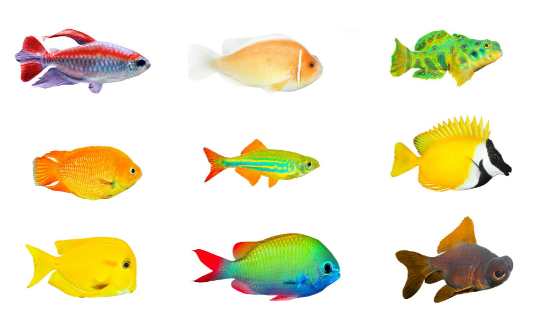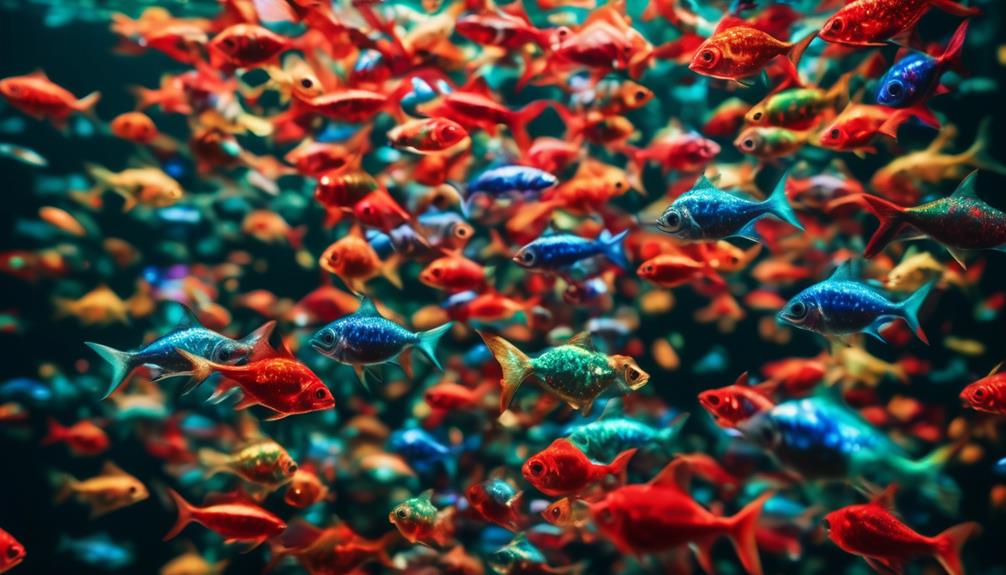
In a world where the colors of fish are often dull and uninspiring, there exists a group of aquatic creatures that have taken it upon themselves to defy the norm.
The tetras, with their vibrant hues and intricate patterns, have created a realm of beauty that captivates the hearts of aquarium enthusiasts.
But what lies beneath the dazzling facade? What secrets do these small, compressed beings hold?
Join us as we embark on a journey into the mesmerizing world of tetra fish, where their unique characteristics and captivating habitats await exploration.
Key Takeaways
- Tetras are a diverse species of tropical fish with over 150 different species.
- They originate from Africa, Central America, and South America, adapting to different freshwater habitats.
- Tetras come in a wide array of vibrant colors and have unique patterns and markings on their bodies.
- Tetras are timid schooling fish that thrive in large groups and make peaceful additions to community tanks.
General Description and Origins of Tetra
Tetras, a popular species of tropical fish in the aquarium trade, originate from various freshwater habitats in Africa, Central America, and South America. With over 150 different species, most tetras have a small, compressed body shape and a tiny adipose fin located between their dorsal and tail fins. These fish have adapted to different environments, with some native to rivers and others found in lakes or swamps. Their natural habitats influence their water requirements, making it important to provide appropriate conditions in the aquarium.
Tetras come in a wide array of vibrant colors, including red, blue, silver, grey, yellow, and white, with different species displaying unique patterns and markings. They’re peaceful and thrive when kept in large groups, appreciating heavily planted aquariums with hiding places.
Tetras are omnivores and readily accept flake-based aquarium foods, although providing a varied diet with live foods can enhance their health and coloration.
Variety of Tetra Species
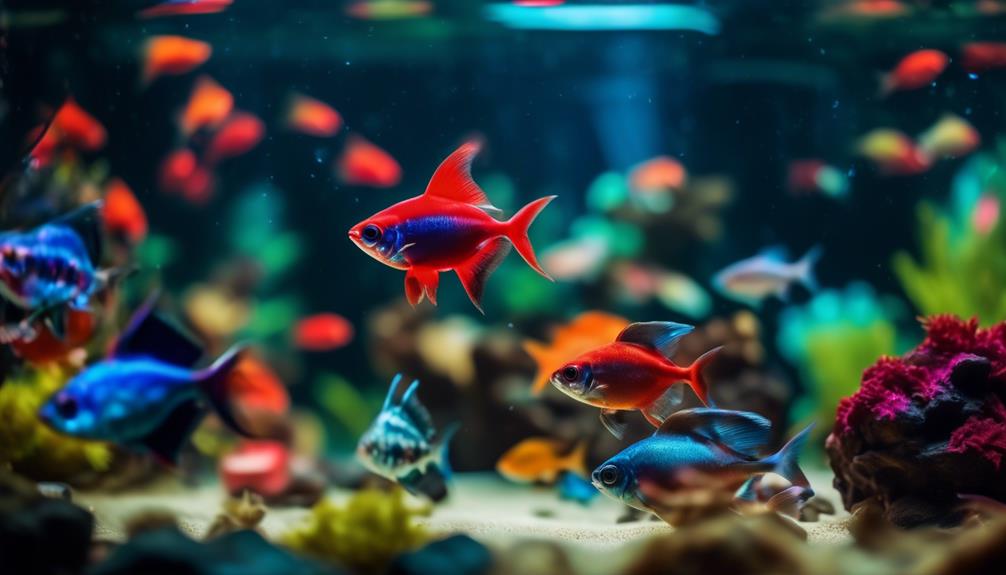
With over 150 different species, tetras present a diverse array of colors, patterns, and adaptations. These tropical fish come in a wide variety of shades and color combinations, including red, blue, silver, grey, yellow, and white. Their vibrant colors make them visually appealing in aquariums, adding a splash of beauty to any tank.
Additionally, some tetras have unique patterns or markings on their bodies, further adding to their visual allure. Each species of tetra has its own distinct characteristics, making them fascinating to observe and care for. From the vibrant Cardinal Tetra to the striking Black Neon Tetra, there’s a tetra species to suit every aquarist’s preference.
The variety of tetra species ensures that there’s never a dull moment in the colorful world of these captivating fish.
Unique Body Shapes of Tetras
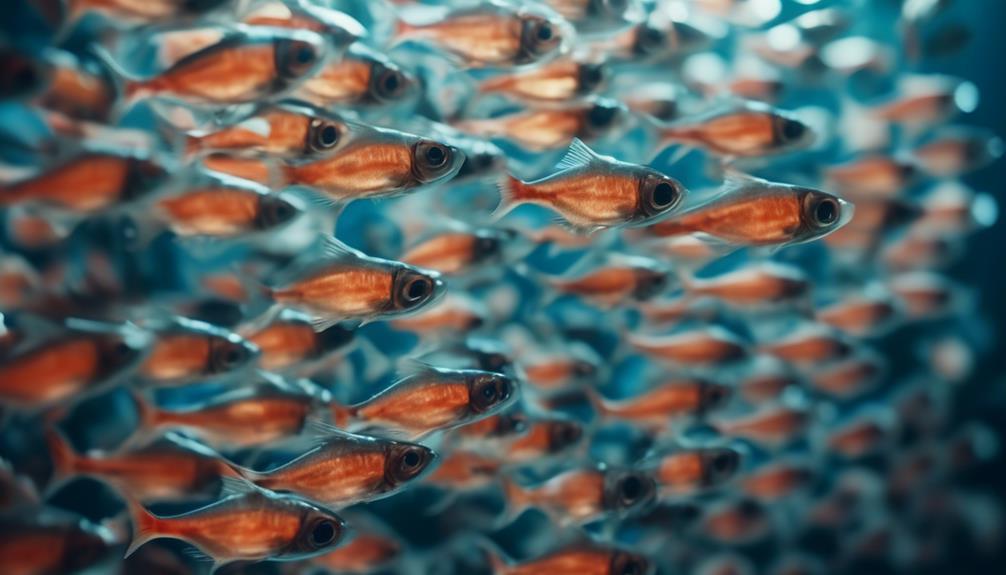
As one explores the fascinating world of tetras, their unique body shapes become an intriguing aspect to observe and appreciate. Here are four distinct body shapes that tetras can have:
- Slender and elongated: Some tetras, like the popular Neon Tetras, have a slender and elongated body shape. This allows them to effortlessly navigate through dense vegetation in their natural habitats.
- Deep-bodied: On the other end of the spectrum, there are tetras with a deep-bodied shape, such as the Black Skirt Tetras. These fish have a rounded belly and a deeper profile, giving them a more robust appearance.
- High-backed: Certain tetras, like the Emperor Tetras, have a unique high-backed body shape. Their dorsal fin is more pronounced, creating an elegant and regal look.
- Torpedo-shaped: Many tetras, including the Serpae Tetras, have a torpedo-shaped body that tapers towards the tail. This streamlined shape allows them to swim swiftly and gracefully.
Each of these body shapes showcases the incredible diversity found within the tetra family, making them a captivating addition to any aquarium.
Adipose Fin: A Distinctive Feature
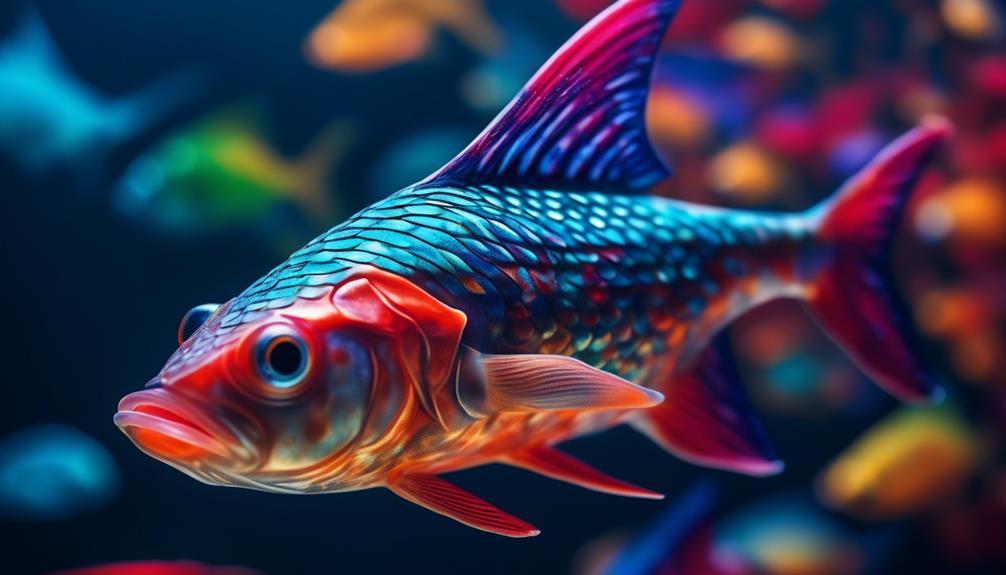
The adipose fin, located between the dorsal and tail fins, is a distinctive feature of tetras that sets them apart from other fish species. This small, fleshy fin serves no apparent purpose and has puzzled researchers for years. While its function remains unknown, the adipose fin is believed to play a role in sensory perception and stability during swimming. It is present in most species of tetras and adds to their unique appearance. Here is a table highlighting some key features of the adipose fin in tetras:
| Adipose Fin in Tetras | |
|---|---|
| Location | Between dorsal and tail fins |
| Size | Small and fleshy |
| Function | Unknown, possibly related to sensory perception and stability |
| Presence | Found in most species of tetras |
| Appearance | Adds to the unique look of tetras |
The adipose fin, though mysterious in its purpose, is a defining characteristic of tetras that contributes to their overall charm.
Tetras’ Native Habitats
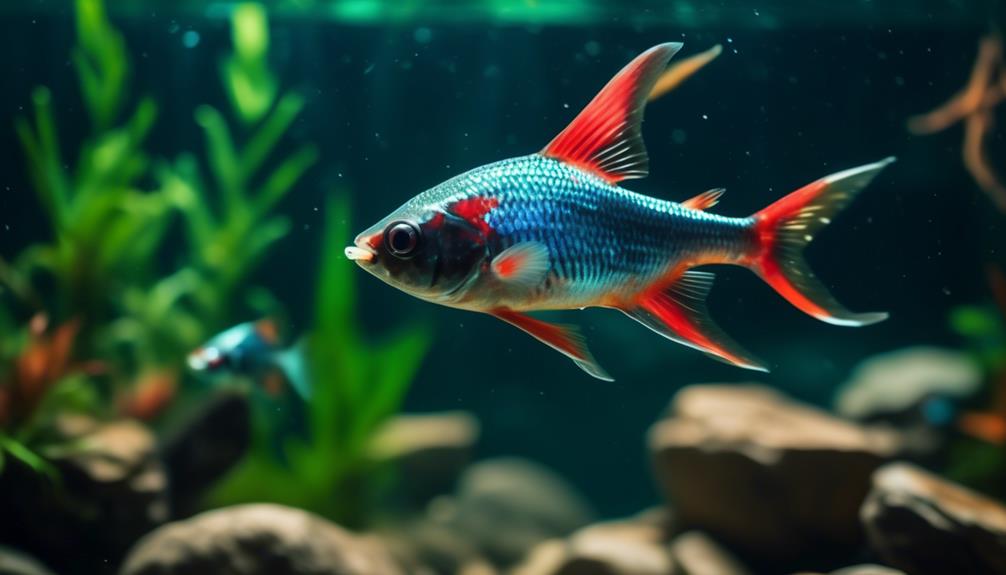
Tetras thrive in a variety of freshwater habitats across Africa, Central America, and South America. Their native habitats influence their water requirements and can vary depending on the species.
Here are four interesting facts about tetras’ native habitats:
- Rivers: Some tetras, like the Cardinal Tetra, are native to flowing rivers. These habitats provide them with the constant movement and oxygenation that they need.
- Lakes: Other tetras, such as the Serpae Tetra, are found in lakes. These habitats offer a more stable environment with calm waters and abundant vegetation.
- Swamps: Certain tetra species, like the Black Skirt Tetra, are native to swamps. Swamps provide them with shallow, slow-moving water and plenty of hiding places among the plants.
- Floodplains: Tetras like the Congo Tetra can be found in floodplains. These habitats experience seasonal flooding, allowing tetras to adapt to changing water conditions and explore new territories.
Understanding the diverse native habitats of tetras is essential for providing them with the right conditions in captivity.
Adaptation to Different Environments
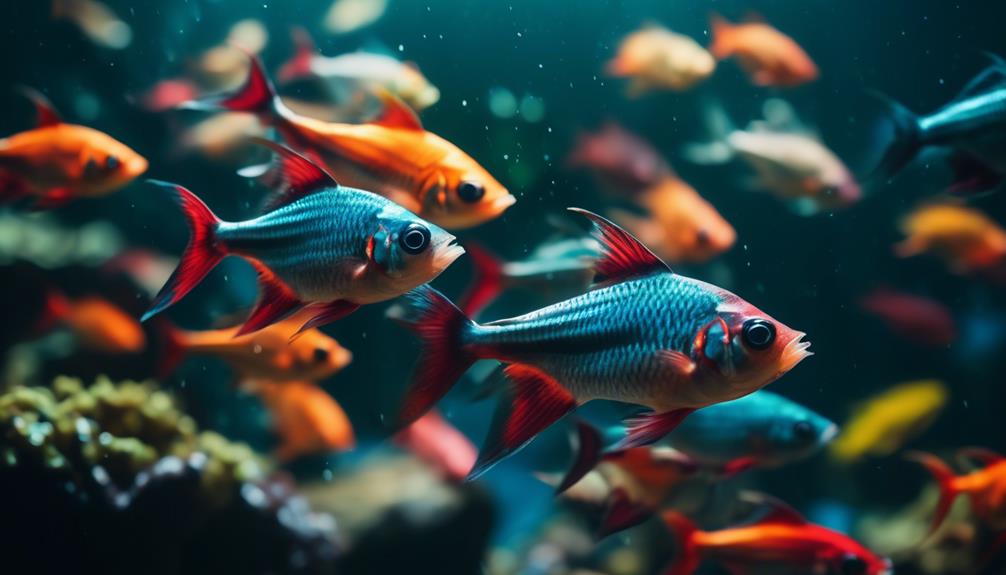
Adapting to a range of environments, tetras have developed unique traits that allow them to thrive in various freshwater habitats. Different species of tetras have evolved specific adaptations to suit their natural habitats.
For instance, tetras native to rivers have streamlined bodies and powerful fins, enabling them to swim against strong currents. On the other hand, tetras found in lakes have adapted to slower-moving water, with broader bodies and more delicate fins.
Some tetras have even adapted to live in swamps, where they’ve developed the ability to breathe air through a labyrinth organ.
These adaptations not only help tetras survive in their respective environments but also contribute to their stunning beauty and resilience in aquariums.
Colorful Appearance of Tetra
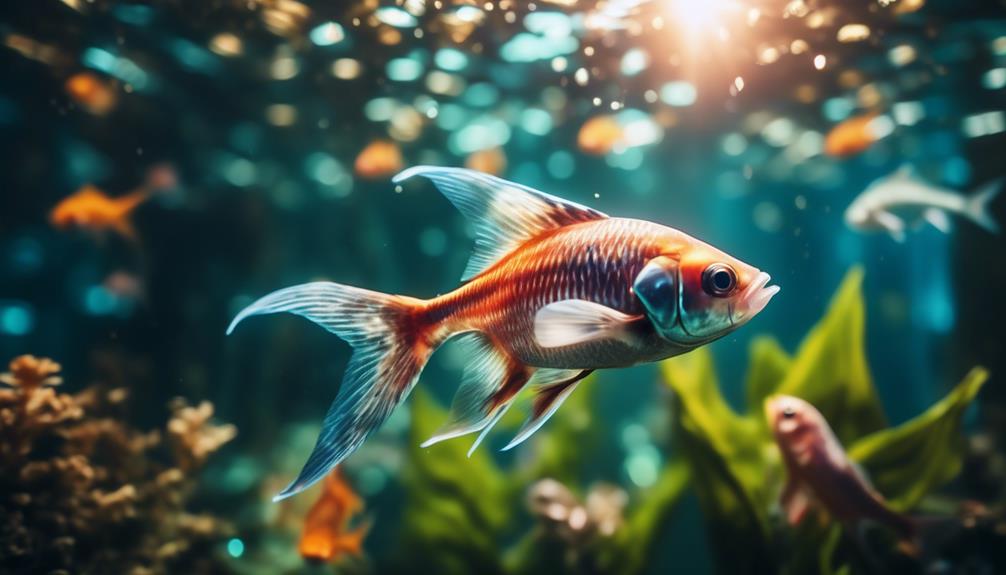
As tetras adapt to different environments, their stunning beauty is showcased through their colorful appearance. Here are four fascinating facts about the colorful appearance of tetras:
- Wide array of colors: Tetras come in a dazzling range of shades and color combinations. From vibrant reds and blues to shimmering silvers and yellows, their colorful hues make them visually appealing in aquariums.
- Unique patterns and markings: Some tetras have distinctive patterns or markings on their bodies, adding to their visual allure. These patterns can vary greatly between species and even within individuals of the same species.
- Species-specific coloration: The coloration of tetras can vary depending on the species. Each species may have its own unique color palette, making them easily distinguishable from one another.
- Individual variation: Just like humans, tetras can exhibit individual variation in their coloration. This means that even within a single species, you may find tetras with slightly different shades or patterns, adding to the diversity and beauty of these fish.
The colorful appearance of tetras adds a vibrant touch to any aquarium, making them a popular choice among fish enthusiasts.
Diverse Color Combinations in Tetras
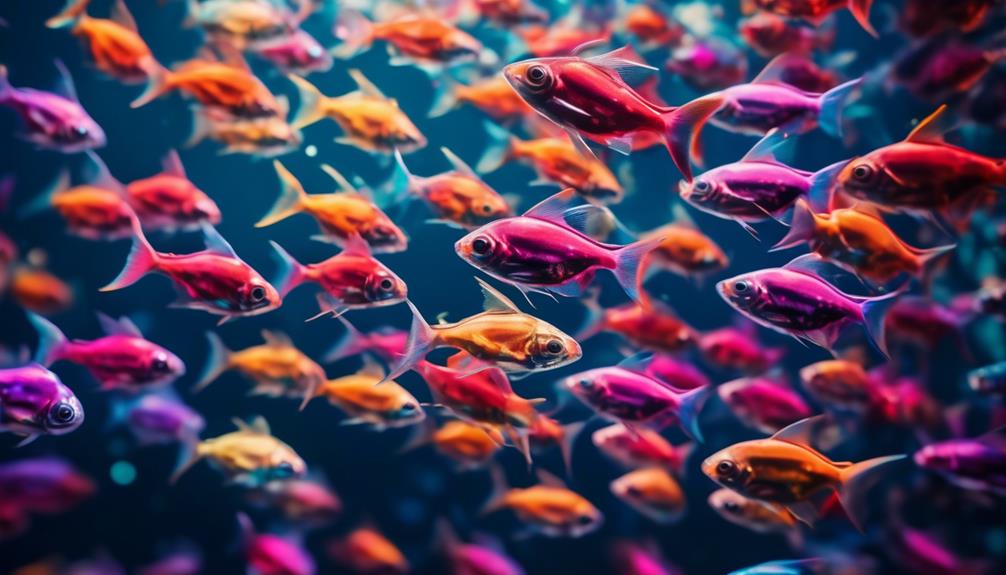
With their stunning array of colors, tetras exhibit diverse and captivating color combinations that add vibrancy to any aquarium. These tropical fish come in a wide range of shades, including red, blue, silver, grey, yellow, and white. Their coloration can vary depending on the species and individual variation, with some tetras even displaying unique patterns or markings on their bodies. To emphasize the diversity of color combinations in tetras, the following table showcases three different species and their distinct colorations:
| Species | Color Combination |
|---|---|
| Neon Tetra | Blue, red, and silver |
| Cardinal Tetra | Red, blue, and black |
| Black Tetra | Black and silver |
Whether it’s the vibrant blue and red hues of the Neon Tetra or the striking contrast between red and black in the Cardinal Tetra, these color combinations make tetras a visually appealing choice for aquarium enthusiasts.
Patterns and Markings on Tetra Bodies
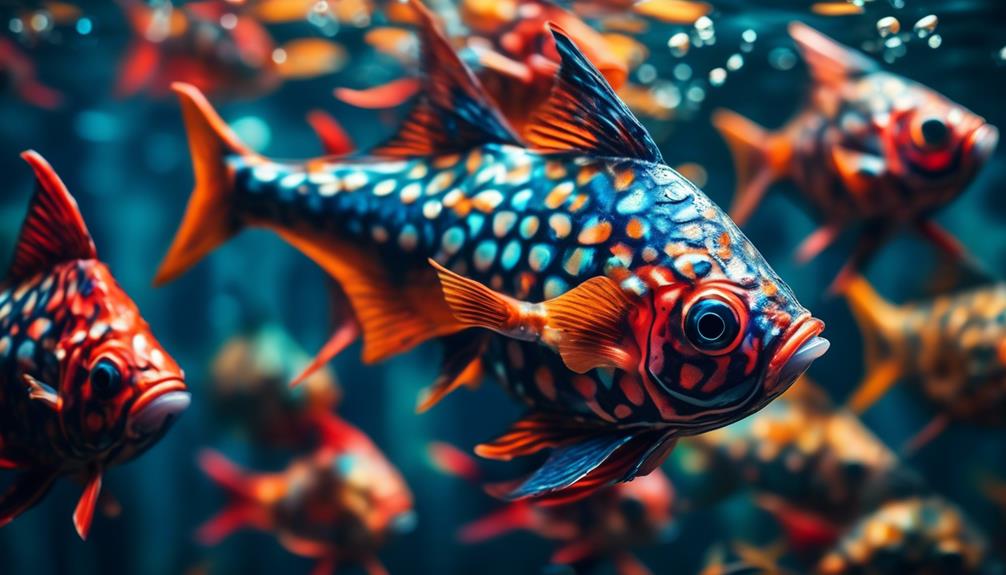
The captivating color combinations of tetras extend beyond their vibrant hues, as their bodies also showcase an array of intriguing patterns and markings. These patterns and markings add to the visual appeal of these tropical fish and make them even more fascinating to observe in an aquarium setting.
Here are four examples of the patterns and markings that can be found on tetra bodies:
- Stripes:
Many tetras have horizontal or vertical stripes that run along their bodies. These stripes can be thick or thin, and they often contrast with the base color of the fish.
- Spots:
Some tetras have spots or speckles on their bodies. These spots can be evenly distributed or concentrated in certain areas, creating a unique pattern.
- Bands:
Certain tetras have bands that wrap around their bodies. These bands can be wide or narrow and can be a different color than the rest of the fish’s body.
- Fin Patterns:
In addition to patterns on their bodies, tetras can also have interesting markings on their fins. These markings can be stripes, spots, or even intricate designs.
Care and Maintenance Tips for Tetra
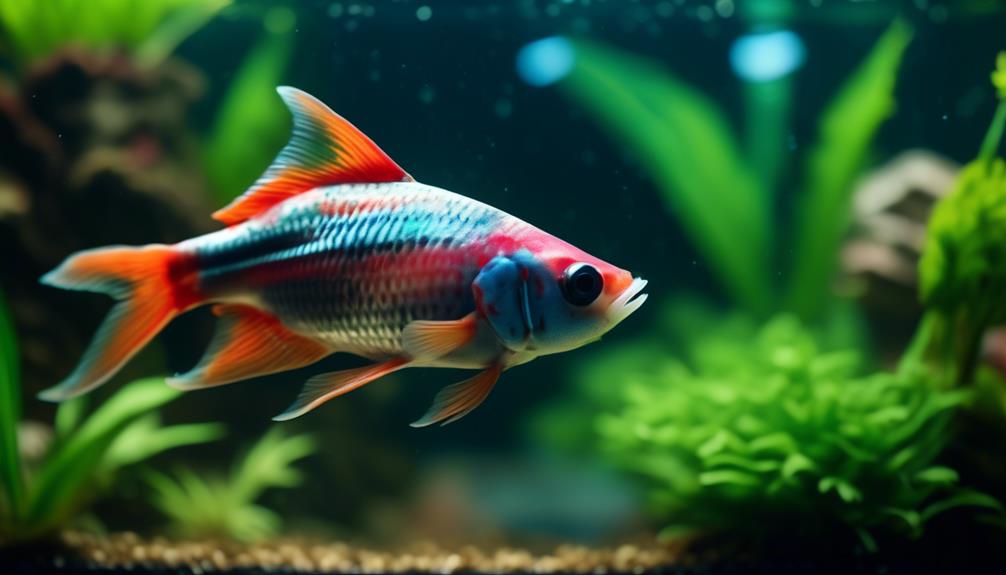
To ensure the health and well-being of tetras, it’s important to provide them with proper care and maintenance.
Tetras are social fish and thrive when kept in large groups of 10 or more. They feel more secure in larger numbers and are active swimmers, so they require open swimming spaces in the aquarium.
Tetras appreciate heavily planted aquariums with hiding places, as they’re timid by nature.
While tetras can adapt to a variety of water conditions, each species has specific requirements. It’s crucial to research the particular needs of the tetra species being kept and maintain the appropriate water parameters.
Additionally, tetras are omnivores and readily accept flake-based aquarium foods, but offering a varied diet with live foods can enhance their health and coloration.
Importance of Grouping Tetras
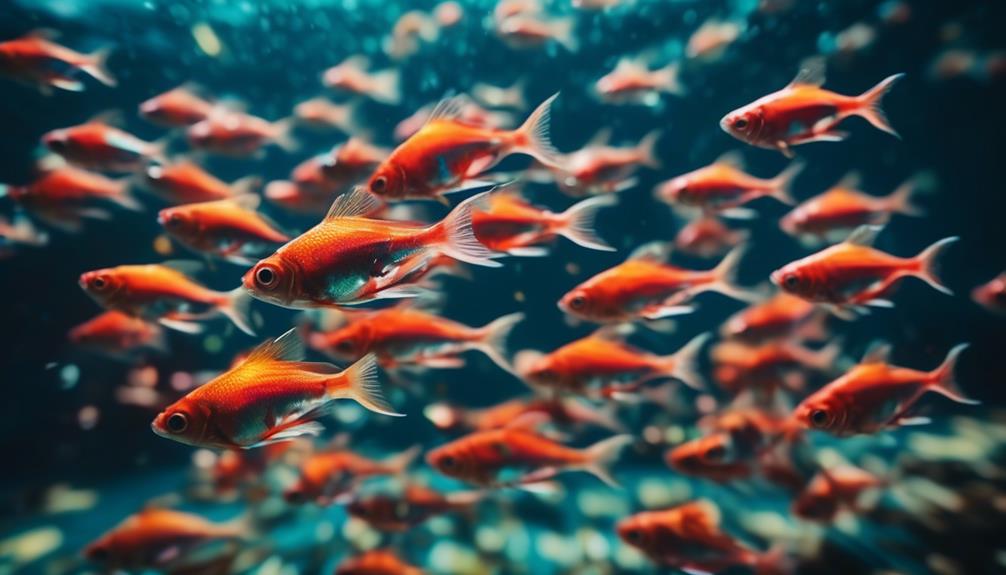
Grouping tetras in large numbers is crucial for their well-being and social behavior. When kept in small groups or alone, tetras can become stressed and exhibit abnormal behavior. Here are four reasons why grouping tetras is important:
- Safety in numbers: Tetras are naturally schooling fish, and they feel more secure when surrounded by their own kind. Being in a group provides them with a sense of safety, reducing stress and anxiety.
- Natural behavior: In the wild, tetras swim together in large schools, coordinating their movements and displaying natural behaviors. By grouping them in the aquarium, you can observe their natural schooling behavior, which adds beauty and interest to the tank.
- Improved health: When tetras are kept in larger groups, they’re more likely to exhibit healthy behaviors. They’ll be more active, eat better, and have a stronger immune system. The overall health and vitality of the fish will be improved.
- Enhanced colors: Tetras are known for their vibrant colors, and when kept in larger groups, their colors tend to intensify. The presence of other tetras stimulates color pigmentation and makes them more visually striking.
Ideal Aquarium Setup for Tetras
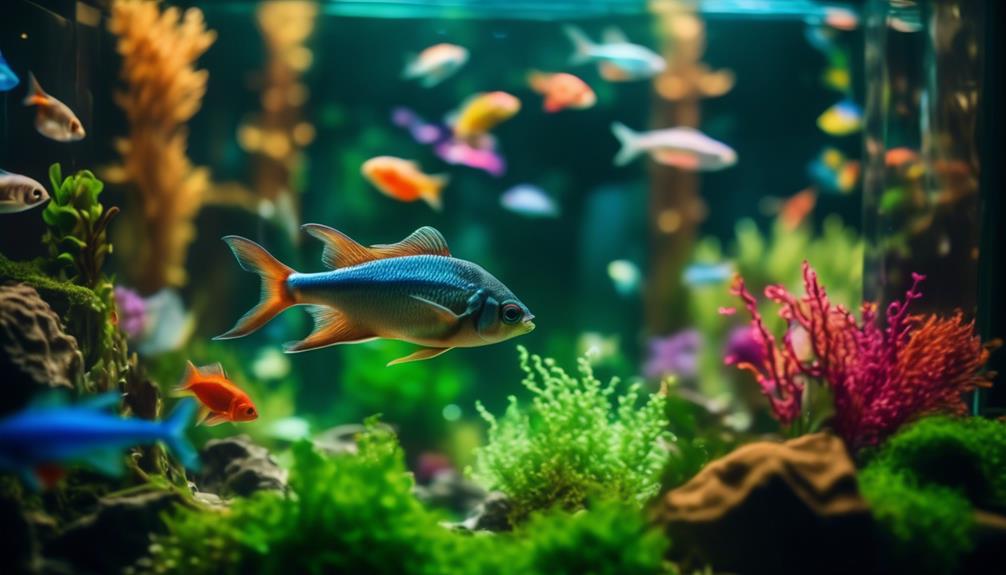
After understanding the importance of grouping tetras, it’s essential to create an ideal aquarium setup for these colorful fish.
Tetras are active swimmers and feel more secure in larger numbers, so it’s recommended to keep them in groups of 10 or more. To accommodate their swimming habits, the aquarium should have ample open swimming spaces.
Tetras also appreciate heavily planted aquariums with hiding places, as this mimics their natural habitat and provides them with a sense of security.
Additionally, it’s important to consider the specific water requirements of each tetra species. While tetras can adapt to a variety of water conditions, it’s necessary to research and provide the appropriate water parameters for their optimal health and well-being.
Water Conditions for Tetras
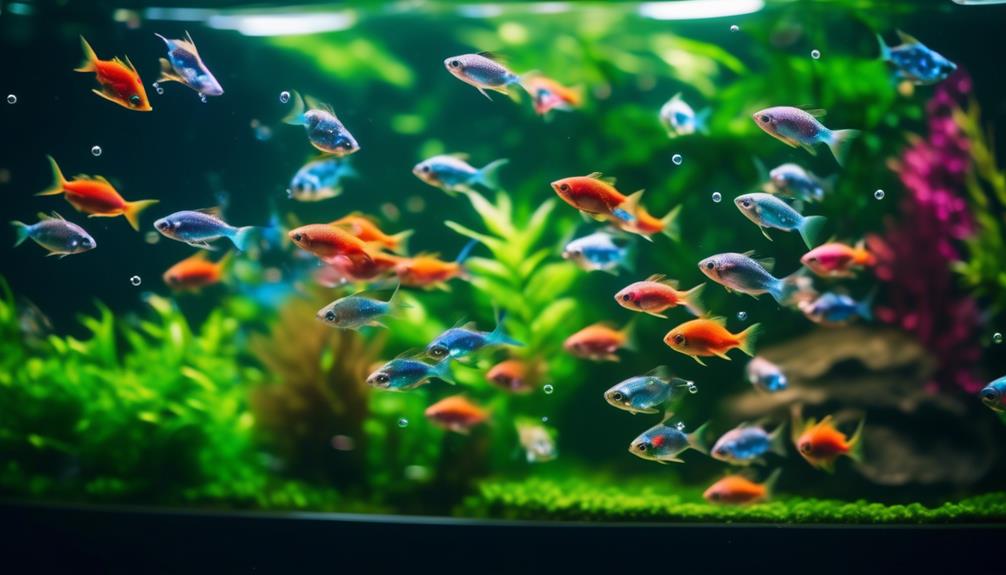
Maintaining appropriate water conditions is crucial for the health and well-being of tetras in an aquarium. Here are four important factors to consider when it comes to water conditions for tetras:
- Temperature: Tetras thrive in water temperatures between 72°F and 78°F (22°C and 26°C). It’s important to use a reliable aquarium heater to maintain a stable temperature.
- pH Level: Most tetras prefer slightly acidic to neutral water with a pH range of 6.5 to 7.5. Regular monitoring and adjustment of the pH level using appropriate buffers or conditioners is essential.
- Water Hardness: Tetras generally prefer soft to moderately hard water, with a hardness level between 4 and 10 dGH. Adding aquarium salts or using a water softener can help achieve the desired water hardness.
- Filtration and Water Quality: A good filtration system is necessary to keep the water clean and free from harmful substances. Regular water changes and the use of dechlorinating agents are also important to maintain optimal water quality for tetras.
Tetras’ Compatibility With Other Fish
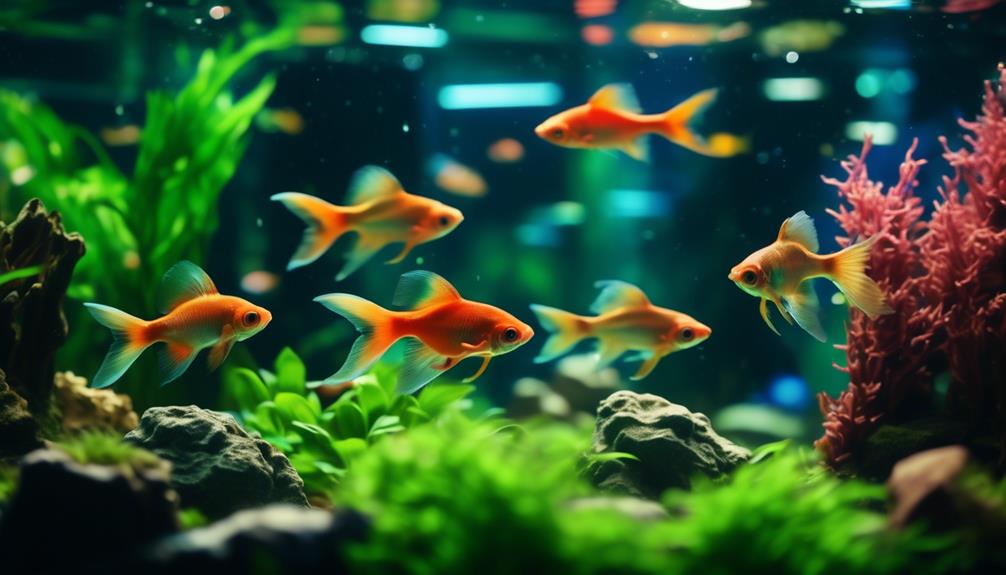
Considering the importance of maintaining optimal water conditions for tetras, it’s essential to understand their compatibility with other fish in the aquarium. Tetras are peaceful and make excellent additions to most community tanks. However, they shouldn’t be kept with aggressive or predatory species.
It’s best to choose tank mates that have similar temperaments and size requirements. Suitable companions for tetras include danios, white cloud minnows, platys, swordtails, and guppies. These fish have similar water temperature and pH preferences, making it easier to maintain a stable environment for all species.
It’s important to note that some tetras may be fin nippers, so it’s advisable to avoid keeping them with long-finned or slow-moving fish. By selecting compatible tank mates, tetras can thrive and display their vibrant colors in a harmonious aquarium environment.
Feeding Habits of Tetra
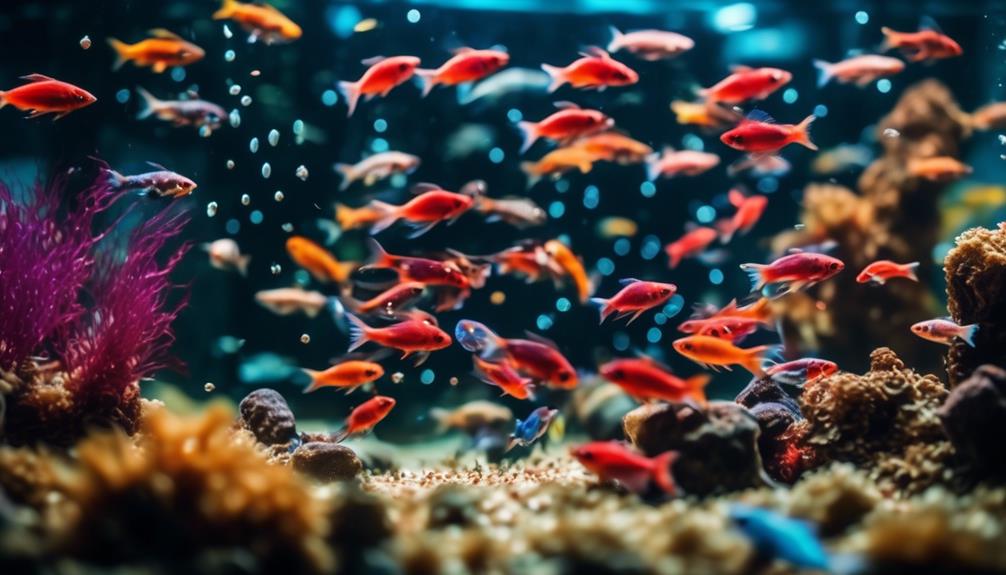
Tetras are omnivorous fish that have a diverse diet consisting of both flake-based aquarium foods and live foods. Here are some important facts about the feeding habits of tetras:
- Flake-based foods: Tetras readily accept flake-based aquarium foods. These foods are designed to provide a balanced diet and contain essential nutrients for their overall health.
- Live foods: Providing a varied diet with live foods can enhance the health and coloration of tetras. They enjoy small live organisms such as brine shrimp, bloodworms, and daphnia. Live foods mimic their natural diet and stimulate their natural hunting instincts.
- Frozen foods: In addition to live foods, tetras can also be fed frozen foods. These include frozen brine shrimp, mosquito larvae, and other small organisms. Frozen foods are a convenient alternative to live foods and still provide nutritional benefits.
- Supplementary foods: Tetras can also benefit from supplementary foods such as spirulina flakes, vegetable-based pellets, and freeze-dried foods. These foods offer additional nutrients and can help promote optimal health for these vibrant fish.
Frequently Asked Questions
Can Tetras Be Kept With Aggressive or Predatory Fish?
Tetras should not be kept with aggressive or predatory fish. They are peaceful and make excellent additions to most community tanks. Suitable tank mates for tetras include danios, white cloud minnows, platys, swordtails, and guppies.
What Are Some Suitable Tank Mates for Tetras?
Some suitable tank mates for tetras include danios, white cloud minnows, platys, swordtails, and guppies. These peaceful fish make excellent additions to most community tanks and should not be kept with aggressive or predatory species.
Do Tetras Have Any Specific Water Requirements?
Tetras, popular in the aquarium trade, have specific water requirements. While they can adapt to various conditions, each species has its own needs. They thrive in heavily planted tanks with hiding places and appreciate open swimming spaces.
Can Tetras Be Fed a Solely Flake-Based Diet?
Yes, tetras can be fed a solely flake-based diet. However, providing a varied diet with live foods can enhance their health and coloration. It is recommended to offer a combination of both for optimal nutrition.
How Can Live Foods Enhance the Health and Coloration of Tetras?
Live foods can enhance the health and coloration of tetras. They provide essential nutrients and variety to their diet. Feeding live foods, such as brine shrimp or daphnia, can promote better growth, vibrant colors, and overall well-being in tetras.
Can Other Types of Tetra Fish Coexist with Neon Tetras in the Same Aquarium?
Yes, other types of tetra fish can coexist with colorful neon tetras in aquarium. Some good tank mates for neon tetras include cardinal tetras, ember tetras, and glowlight tetras. However, it is important to consider their size, temperaments, and water requirements before introducing them into the same tank.
Conclusion
In conclusion, the world of tetra fish is a vibrant and captivating one. With their diverse colors, unique body shapes, and peaceful nature, tetras make for excellent additions to any aquarium.
By providing them with the ideal habitat and water conditions, as well as compatible tank mates, enthusiasts can create a stunning aquatic kingdom that showcases the beauty of these mesmerizing creatures.
Don’t miss out on the opportunity to dive into the colorful world of tetra fish.




